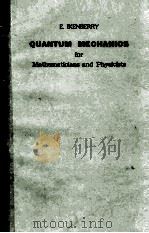《THERMODYNAMICS An Advanced Treatment for Chemists and Physicists》
| 作者 | E.A.GUGGENHEIM 编者 |
|---|---|
| 出版 | 未查询到或未知 |
| 参考页数 | 390 |
| 出版时间 | 没有确切时间的资料 目录预览 |
| ISBN号 | 0444869514 — 求助条款 |
| PDF编号 | 812246018(仅供预览,未存储实际文件) |
| 求助格式 | 扫描PDF(若分多册发行,每次仅能受理1册) |

Introduction concerning notation and terminology1
CHAPTER 1Fundamental principles5
1.01 Scope of thermodynamics5
1.02 Thermodynamic state.Phases6
1.03 Thermodynamic process7
1.04 Infinitesimal process7
1.05 Insulating walls.Adiabatic processes7
1.06 Conducting walls.Thermal equilibrium8
1.07 Zeroth law.Temperature8
1.08 Thermostats and thermometers8
1.09 Temperature scales9
1.10 Energy and heat.First law9
1.11 Conversion of work to heat11
1.12 Natural and reversible processes12
1.13 Reversible process and reversible change13
1.14 Equilibrium and reversible changes14
1.15 Closed systems and open systems14
1.16 Entropy14
1.17 Thermal equilibrium15
1.18 Thermodynamic temperature15
1.19 Entropy and heat16
1.20 Second law17
1.21 Units18
1.22 Extensive properties18
1.23 Intensive properties19
1.24 Chemical content of phase19
1.25 Chemically inert species19
1.26 Partial and proper quantities20
1.27 Chemical potentials21
1.28 Characteristic functions.Fundamental equations22
1.29 Mole fractions24
1.30 Gibbs-Duhem relation25
1.31 Multiphase systems25
1.32 Adiabatic changes in closed system26
1.33 Isothermal changes in closed systems26
1.34 Equilibrium conditions.General form27
1.35 Stability and metastability28
1.36 Thermal internal stability30
1.37 Hydrostatic equilibrium31
1.38 Hydrostatic internal stability31
1.39 Equilibrium distribution between phases32
1.40 Phase stability33
1.41 Gibbs’phase rule33
1.42 Membrane equilibrium34
1.43 Chemical reactions.Frozen equilibrium34
1.44 Chemical equilibrium.Affinity35
1.45 Choice of independent variables38
1.46 Thermal expansivity and isothermal compressibility38
1.47 Maxwell’s relations39
1.48 Dependence of thermodynamic functions on pressure39
1.49 Gibbs-Helmholtz relation40
1.50 Dependence of thermodynamic functions on T,V41
1.51 Use of Jacobians41
1.52 Reversible cycles43
1.53 Surface phases45
1.54 Interfacial tension of plane interface46
1.55 Helmholtz function of surface layer47
1.56 Integrated relation.Gibbs function of surface phase47
1.57 Analogue of Gibbs-Duhem relation48
1.58 Invariance of relations49
1.59 Gibbs geometrical surface49
1.60 Interfacial tension of curved interface50
1.61 Pressure within a bubble52
1.62 Determination of interfacial tension53
1.63 Independence of interfacial tension of curvature54
1.64 Mathematical analysis of curved interface55
1.65 Basis of thermodynamic laws58
1.66 Third law60
CHAPTER 2Digression on statistical thermodynamics61
2.01 Microdescriptions and macrodescriptions of a system61
2.02 System of given energy,volume,and composition62
2.03 Characteristic of macroscopic system63
2.04 System of given temperature,volume,and composition65
2.05 Further characteristics of macroscopic system68
2.06 System of given temperature,pressure,and composition69
2.07 System of given temperature,pressure,and chemical potential70
2.08 Recapitulation72
2.09 Extension to several components.Absolute activities73
2.10 Antisymmetric and symmetric eigenfunctions73
2.11 Fermi-Dirac and Bose-Einstein statistics74
2.12 Boltzmann statistics75
2.13 Partition functions of units and thermodynamic functions76
2.14 Separable degrees of freedom77
2.15 Classical and unexcited degrees of freedom77
2.16 Translational degrees of freedom78
2.17 Third law of thermodynamics80
CHAPTER 3Systems of a single component82
3.01 Single components and single phases82
3.02 Dependence of entropy on temperature82
3.03 Heat capacity at constant pressure85
3.04 So-called mechanical equivalent of heat86
3.05 Dependence of entropy on pressure87
3.06 Heat capacity at constant volume88
3.07 Relation between heat capacities89
3.08 Adiabatic compressibility89
3.09 Condensed phases and gases90
3.10 Isothermal behaviour of a gas90
3.11 Throttling92
3.12 Measurement of thermodynamic temperature93
3.13 The gas constant and the mole94
3.14 Isothermal equation of a gas95
3.15 Absolute activity95
3.16 Thermodynamic functions of a gas96
3.17 Fugacity97
3.18 Gases at high temperatures97
3.19 Slightly imperfect gases98
3.20 Joule-Thomson coefficient99
3.21 Temperature dependence of second virial coefficient99
3.22 Boyle temperature and inversion temperature100
3.23 Relation between heat capacities of slightly imperfect gas101
3.24 Adiabatic change of a gas101
3.25 Temperature dependence of μ? and λ?102
3.26 Monatomic molecules103
3.27 Numerical values in entropy constant103
3.28 Linear molecules104
3.29 Non-linear molecules105
3.30 Pressure dependence for condensed phases108
3.31 Temperature dependence for liquids110
3.32 Crystals at very low temperatures111
3.33 Crystals at intermediate temperatures.Debye’s approximation112
3.34 Corresponding temperatures of crystals116
3.35 Comparison of Debye’s functions with Einstein’s functions116
3.36 Equilibrium between two phases118
3.37 Relation between temperature and pressure for two-phase equilib-rium118
3.38 Clapeyron’s relation applied to two condensed phases119
3.39 Clapeyron’s relation applied to saturated vapour120
3.40 Heat capacities of two phases in equilibrium121
3.41 Heat capacities at saturation122
3.42 Temperature dependence of enthalpies of evaporation and of fusion123
3.43 Triple points124
3.44 Critical points126
3.45 Continuity of state129
3.46 Two phases at different pressures132
3.47 Fugacity of a condensed phase134
3.48 Corresponding states of fluids135
3.49 Corresponding states of solids140
3.50 Two simple equations of state141
3.51 Zero-temperature entropy in crystals144
3.52 Two numerical examples146
3.53 Statistical-mechanical interpretation148
3.54 Simple typical exceptions148
3.55 Isotopic mixing150
3.56 The exceptional case of hydrogen151
3.57 Third law of thermodynamics and the Nernst heat theorem154
3.58 Thermal expansion at low temperatures156
3.59 Unattainability of zero temperature157
3.60 Interfacial layers159
3.61 Temperature dependence of surface tension160
3.62 Invariance of relations161
3.63 Simplifying approximation161
3.64 Vapour pressure of small drops162
3.65 Empirical temperature dependence of surface tension163
3.66 Corresponding states of surface tension166
3.67 Sorption of a single gas166
3.68 Temperature dependence of sorption167
CHAPTER 4Mixtures170
4.01 Introduction170
4.02 Composition of mixture170
4.03 Partial and proper quantities171
4.04 Relations between partial quantities173
4.05 Partial quantities at high dilution173
4.06 Perfect gaseous mixture173
4.07 Slightly imperfect gaseous mixture175
4.08 Fugacities of gases177
4.09 Liquid mixtures177
4.10 Liquid-vapour equilibrium177
4.11 Azeotropy178
4.12 Relative activities and fugacities in liquids180
4.13 Pressure dependence182
4.14 Osmotic equilibrium182
4.15 Pressure on semi-permeable membrane184
4.16 Duhem-Margules relation185
4.17 Temperature coefficients186
4.18 Ideal mixtures186
4.19Thermodynamic functions of ideal mixtures187
4.20 Fugacities in ideal mixtures188
4.21 Osmotic pressure of ideal solution190
4.22 Non-ideal mixtures190
4.23 Functions of mixing and excess functions191
4.24 Volatility ratio192
4.25 Internal stability with respect to composition194
4.26 Critical mixing195
4.27 Excess functions expressed as polynomials196
4.28 Symmetrical mixtures196
4.29 Simple mixtures197
4.30 Critical mixing in simple mixtures200
4.31 Critical mixing in symmetrical mixtures203
4.32 Example of unsymmetrical mixture203
4.33 Athermal mixtures of small and large molecules205
4.34 Osmotic pressure in athermal mixtures206
4.35 Interfacial layers207
4.36 Liquid-vapour interface207
4.37 Invariance of relations208
4.38 Temperature coefficient of surface tension209
4.39Variations of composition210
4.40 Example of water+ethanol211
4.41 Interface between two binary liquids213
4.42 Temperature dependence of interfacial tension214
4.43 Accurate formulae215
4.44 Solid mixtures217
4.45 Stationary melting points218
4.46 Solid ideal mixtures218
4.47 Excess functions219
CHAPTER 5Solutions,especially dilute solutions220
5.01 Introduction220
5.02 Mole ratios and molalities220
5.03 Partial and apparent quantities221
5.04 Gibbs-Duhem relation222
5.05 Partial quantities at high dilution223
5.06 Ideal dilute solutions223
5.07 Thermodynamic functions of ideal dilute solutions224
5.08 Real solutions226
5.09 Activity coefficients of solute species226
5.10 Osmotic coefficient of solvent227
5.11 Relation between activity coefficients and osmotic coefficient227
5.12 Temperature dependence227
5.13 Pressure dependence228
5.14 Temperature dependence of fugacity of solvent229
5.15 Temperature dependence of fugacity of solute229
5.16 Osmotic pressure229
5.17 Freezing point230
5.18 Boiling point232
5.19 Distribution between two solvents233
5.20 Solubility of pure solid233
5.21 Experimental determination of ?234
5.22 Determination of γ from ?235
5.23 Fugacity of saturated solution236
5.24 Surface tension237
5.25 Temperature dependence238
5.26 Variations of composition238
5.27 Interfacial tension between two solutions238
5.28 Volume concentrations239
CHAPTER 6Systems of chemically reacting species240
6.01 Notation and terminology240
6.02 Enthalpy of reaction241
6.03 Hess’law242
6.04 Kirchhoff’s relations243
6.05 Prescription of standards243
6.06 Construction of tables244
6.07 Gaseous equilibria245
6.08 Equilibria between gases and solids246
6.09 Temperature dependence247
6.10 Numerical example248
6.11 Reactions between pure solids or liquids248
6.12 Transition of sulphur250
6.13 Homogeneous equilibrium in solution251
6.14 Temperature dependence252
6.15 Use of volume concentrations252
6.16 Heterogeneous equilibria involving solutions252
6.17 Transitions of second order252
6.18 Cooperative systems255
6.19 Alternative notation257
6.20 Lambda point257
6.21 Comparison with phase change and critical point261
6.22 Dependence of lambda point on pressure262
6.23 Transitions of higher order264
6.24 Components and degrees of freedom265
CHAPTER 7Solutions of electrolytes268
7.01 Characteristics of strong electrolytes268
7.02 Ionic mole ratios and ionic molalities268
7.03 Electrical neutrality269
7.04 Ionic absolute activities270
7.05 Ideal dilute and real solutions272
7.06 Osmotic coefficient of the solvent272
7.07 Freezing point and boiling point272
7.08 Osmotic pressure273
7.09 Ionic activity coefficient273
7.10 Mean activity coefficient of electrolyte273
7.11 Temperature dependence275
7.12 Distribution of electrolyte between two solvents275
7.13 Solubility276
7.14 Chemical reactions277
7.15 Gibbs-Duhem relation for electrolyte solutions277
7.16 Limiting behaviour at high dilutions280
7.17 Limiting law of Debye and Hückel281
7.18 Aqueous solutions283
7.19 Less dilute solutions284
7.20 Formulae of Debye and Hückel284
7.21 Specific interactions286
7.22 Chemical reactions involving solvent289
7.23 Acid-base equilibrium290
7.24 Weak electrolytes293
7.25 Surface phases293
CHAPTER 8Electrochemical systems298
8.01 Electrically charged phases298
8.02 Phases of identical composition299
8.03 Electrochemical potentials299
8.04 Absolute activities of ions302
8.05 Dilute solutions in common solvent302
8.06 Volta potentials304
8.07 Membrane equilibrium(non-osmotic)304
8.08 Osmotic membrane equilibrium305
8.09 Contact equilibrium307
8.10 Examples of galvanic cell307
8.11 General treatment of electromotive force311
8.12 Temperature dependence313
8.13 Application of Nernst’s heat theorem313
8.14 Cells without transference316
8.15 Standard electromotive force317
8.16 Numerical example318
8.17 Standard electromotive force of half-cell320
8.18 Cells with transference with two similar electrodes321
8.19 Cells containing single electrolytes324
8.20 Cells with transference having two dissimilar electrodes326
CHAPTER 9Gravitational field327
9.01 Nature of gravitational field327
9.02 Phases in gravitational field327
9.03 Thermodynamic functions in gravitational field327
9.04 Equilibrium in gravitational field328
9.05 Dependence of μi on T and P328
9.06 Single component in gravitational field329
9.07 Mixture in gravitational field330
9.08 Mixture of gases331
9.09 Ideal dilute solutions331
9.10 Chemical reaction in gravitational field332
CHAPTER 10Electrostatic systems333
10.01 Introduction333
10.02 Parallel-plate capacitor in vacuo333
10.03 Parallel-plate capacitor in fluid333
10.04 Work of charging a capacitor334
10.05 Characteristic functions334
10.06 Analogues of Maxwell’s relations335
10.07 Constant permittivity.Dielectric constant335
10.08 Integrated formulae336
10.09 Application to perfect gas336
CHAPTER 11Magnetic systems338
11.01 Introduction338
11.02 Fundamental electromagnetic vectors339
11.03 Permittivity and permeability in a vacuum339
11.04 Simplest examples of field in a vacuum341
11.05 Presence of matter342
11.06 Electric and magnetic work344
11.07 Formula for Helmholtz function346
11.08 Other thermodynamic functions347
11.09 Case of linear induction348
11.10 Specimen in uniform external field348
11.11 Other thermodynamic functions350
11.12 Specimens of simple shape350
11.13 Diamagnetic,paramagnetic,and ferromagnetic substances351
11.14 Simple paramagnetic behaviour351
11.15 Entropy of simple paramagnetic substances355
11.16 Adiabatic demagnetization355
11.17 Unattainability of zero temperature356
CHAPTER 12Radiation357
12.01 General considerations357
12.02 Energy and entropy in terms of gi’s357
12.03 Thermodynamic functions359
12.04 Evaluation of integrals359
12.05 Stefan-Boltzmann law360
12.06 Adiabatic changes360
CHAPTER 13Onsager’s reciprocal relations362
13.01 Introduction362
13.02 Electric insulators and conductors362
13.03 Onsager’s reciprocal relations365
13.04 Electrokinetic effects366
13.05 Electric double layer368
13.06 Electrochemical cells with transference369
13.07 Thermoelectricity371
13.08 Seebeck effect and thermoelectric power372
13.09 Peltier effect374
13.10 Kelvin’s second relation374
13.11 Thomson effect375
13.12 Interdiffusion of two fluids375
13.13 Interdiffusion of two solutes in dilute solution376
CHAPTER 14Systems in motion378
14.01 Introduction378
14.02 Mechanics and hydrodynamics378
14.03 Entropy379
14.04 Thermal equilibrium379
14.05 Temperature379
14.06 Fundamental equations380
Author index381
Subject index383
《THERMODYNAMICS An Advanced Treatment for Chemists and Physicists》由于是年代较久的资料都绝版了,几乎不可能购买到实物。如果大家为了学习确实需要,可向博主求助其电子版PDF文件。对合法合规的求助,我会当即受理并将下载地址发送给你。
高度相关资料
-

- AN INTRODUCTION TO VECTOR ANALYSIS FOR PHYSICISTS AND ENGINEERS
- 1970 CHAPMAN AND HALL
-

- SOLUTIONS MANUAL FOR ADVANCED ENGINEERING THERMODYNAMICS
- 1988 JOHN WILEY & SONS
-

- MANIFOLD THEORY AN INTRODUCTION FOR MATHEMATICAL PHYSICISTS
- 1991 ELLIS HORWOOD
-

- Numerical analysis for engineers and physicists
- 1976 Springer-Verlag
-

- BASIC INSTRUMENTATION FOR ENGINEERS AND PHYSICISTS
- 1968 PERGAMON PRESS LTD.
-

- THERMODYNAMICS FOR CHEMISTS AND BIOLOGISTS
- 1968 ADDISON-WESLEY PUBLISHING COMPANY
-

- Mathematics for Chemists
- 1984 Chapman and Hall
-

- PHYSICAL CHEMISTRY AN ADVANCED TREATISE VOLUME I/THERMODYNAMICS
- 1971 ACADEMIC PRESS . NEW YORK /LONDON
-

- THERMODYNAMICS AN ADVANCED TREATMENT FOR CHEMISTS AND PHYSICSTS SECOND EDITION
- 1950 NORTH-HOLLAND PUBLISHING COMPANY
-

- ELECTRICITY AND MAGNETISM AN ADVANCED TEXTBOOK FOR COLLEGES
- 1930 THE MACMILLAN COMPANY
-

- AN INTRODUCTION TO THE THEORY OF ELASTICITY FOR ENGINEERS AND PHYSICISTS SECOND EDITION
- 1941 OXFORD UNIVERSITY PRESS
-

- ADVANCED WASTEWATER TREATMENT
- 1971 VAN NOSTRAND REINHOLD COMPANY
提示:百度云已更名为百度网盘(百度盘),天翼云盘、微盘下载地址……暂未提供。➥ PDF文字可复制化或转WORD


